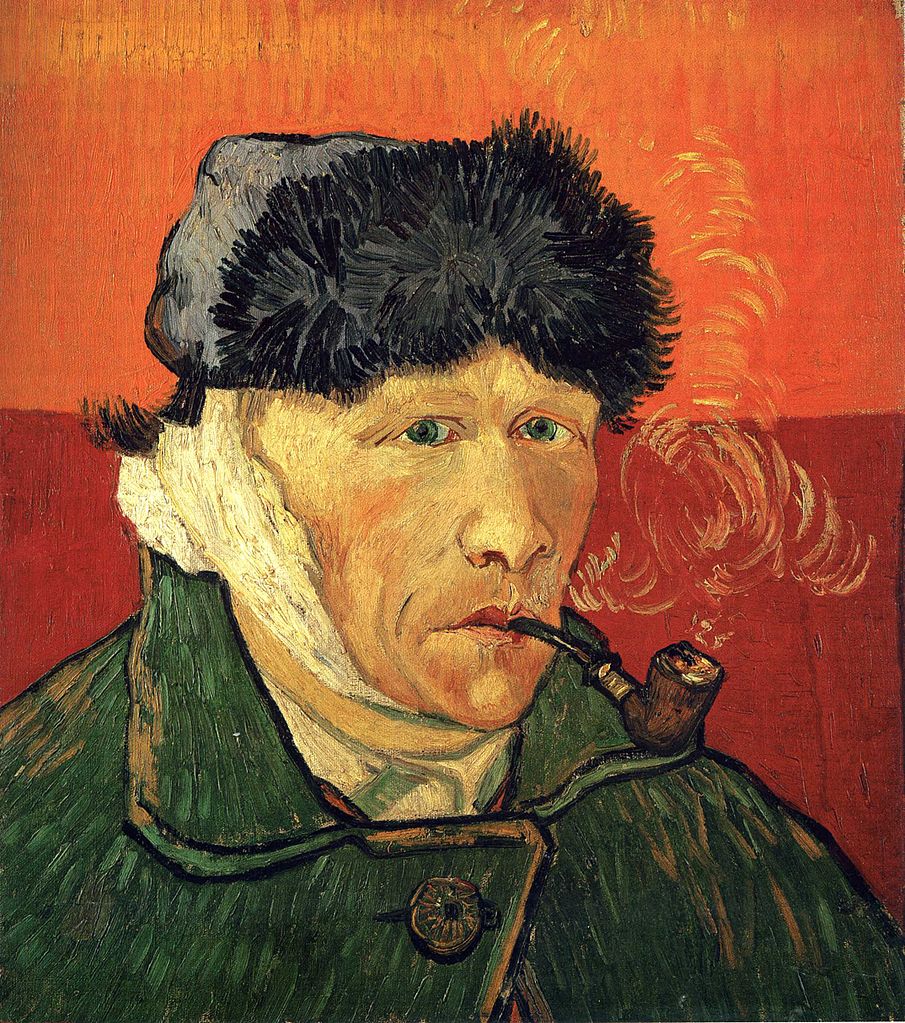Vincent Van Gogh was an admired artist, who was also a troubled and “tortured genius.” His artwork, Starry Night, Bedroom in Arles, and many others have earned him fame and recognition as one of the greatest artists of his time. But what many remember most about this artist is the story of his severed ear. Although his art is exemplary, his struggle with mental health and self-harm is admirable. His struggle was overlooked due to his incredible talent. He was successful as an art dealer, but as an artist, he had to prove himself with the headquarters of international art dealers, Gopil & Cie. During his lifetime, Van Gogh was the poster boy for the image of starving artist. His artwork was not recognized until much later in his career, which could have been a leading cause of his major depression and anxiety.1
Van Gogh, born in the Netherlands, decided to start his career in Paris in the 1880s, where many of the age’s great artists also resided. He believed he could get recognition for his pieces through his younger brother, Theo, who made his living as an art dealer. His brother introduced him to many artists, including Georges Seaurat, Camille Pisatto, and Paul Gauguin. Upon meeting these successful artists, Van Gogh was greatly inspired by their work and began creating his own artistic style, beginning in 1883. Later the same year, Van Gogh rented a small house in Arles, in the south of France. Paul Gauguin and Van Gogh became close friends and later roommates. They consistently bounced ideas off of each other and created a strong friendship.2

Like many friendships, theirs was rocky, and they found themselves drifting apart. Gauguin had moved on to a different artistic style and was exploring other ideas. Van Gogh at the time, had been reciprocating signs of depression and mental health issues, but at the time, these symptoms were considered normal. When Gauguin decided to explore other art spectrums, it involved moving out of the house he and Van Gogh shared. He broke the news to his roommate about his intentions, and this evidently this made Van Gogh go over the edge. He did not take the news lightly and both men began verbally arguing. Van Gogh had disappeared for a few hours and when he returned to confront Gauguin, he had a razor blade in hand threatening to hurt Gauguin.3
During the confrontation, however, Van Gogh was hesitant to hurt his friend and decided to turn the blade on himself and completely cut off his ear. Gauguin left him bleeding and alone. Van Gogh bandaged his head and began drowning himself in alcohol. During this episode, he walked out of his home and into the streets where he found a prostitute. The ear that he had severed off of himself had been neatly wrapped in a cloth; since Van Gogh was still heavily intoxicated, he decided to present this token to the prostitute. Patiently, she ran off and alerted the police about her encounter and they immediately rushed to his home.4
Shortly before Christmas Eve, Van Gogh was found by police in his bed, partially conscious and with major blood loss. Authorities rushed him to the hospital where he surprisingly recovered. Meanwhile, Gauguin was brought into questioning, but gave no testimony on the incident. It was believed that Van Gogh had suffered a severe mental breakdown long before he had severed his ear, but that this created a ripple effect that led to lunacy. The real reason behind the infamous Van Gogh ear-cutting may never be known; Gauguin had promised Van Gogh a pact of silence on the situation in letters that they supposedly exchanged. 5

After the incident, Van Gogh was admitted into a psychiatric facility in hopes of recovering mentally and physically. The dramatic change was not helpful for such a troubled artist, and in July of 1890, Vincent Van Gogh ended his life with a revolver. Before his suicide, however, he created a very iconic painting, Self Portrait with Bandaged Ear 1889. Van Gogh intended to persuade his doctors that he was perfectly able to continue working and creating art by creating this self portrait. He presented his piece, leaving a trail of wonder for his supporters as to why he included certain details in this particular piece, mainly because he continued to paint himself in the same yellow house he and Gauguin shared. Doctors overlooked these details and allowed Van Gogh to leave the facility.6
The epidemy of many artists like Van Gogh is often associated with mental instability, drug use, and alcohol abuse. Van Gogh had an array of medical issues that were tied back to his coping mechanisms (alcohol abuse), and as a result, many did not understand the struggles he faced and degraded him as a person while idolizing his artistic talent. As said before, the real reason behind his mutilated ear will be unclear, but his work and talent will continue to inspire and educate.
- Adam Gopnik, “Van Gogh’s Ear,” The New Yorker, Literature Resource Center (January 4, 2010): 48. ↵
- “Who Really Cut Off Van Gogh’s Ear?” Weekend All Things Considered, Literature Resource Center, (May 2010). ↵
- “Who Really Cut Off Van Gogh’s Ear?” Weekend All Things Considered, Literature Resource Center, (May 2010). ↵
- Belinda Thomson, “Comparing lives: issues of balance in biographical writing,” Literature Resource Center, French Politics, Culture and Society 24, no. 2 (2006): 60. ↵
- Tim Suermondt, “All the Answers.” Literature Resource Ceter, Prairie Schooner 85, no.3 (2011): 47. ↵
- Tim Suermondt, “All the Answers,” Literature Resource Center, Prairie Schooner 85, no. 3 (2011): 47. ↵



170 comments
Christopher Metta Bexar
Like a previous reviewer I had heard several ideas on the loss of the ear, almost none of them directly tied to his mental illness.
I had known that Van Gogh was Dutch , and had made most of his fame during his life in his native Netherlands. I had also heard about him giving the ear to a prostitute. One version of the ear cutting was that the woman was his lover who had spurned him.
But as the article said there was almost no stigma attached to depression and mental illness in the art world of the 19th century. So his problems would have went untreated.
Clarissa Gonzalez
Van Gogh’s story is always a sad one. He’s the literal poster child for the saying “you don’t know what you have until it’s gone”. He went almost his entire career believing he was failing and that his art would not catch on, but it wasn’t until he would pass away that his career would finally take off. His life and work has obviously left a mark deep on the world’s art community, but it has brought attention to mental disorders, even in the smallest ways.
Natalie Juarez
I recently visited Amsterdam a few months ago, where the Van Gogh museum is and learned about his art. Looking at his art, I would never have thought how troubled he was feeling and the battles he faced with his mental health. Before he ended his life, he left art that would educate people around the world. This article was informative and well written. I learned about Van Gogh and his struggle with mental illness that many people overlook.
Alexander Manibusan
To hear that no one exactly knows why Vincent Van Gogh cut his ear sounds frightening. What exactly was the cause that triggered all of the suffering that this artistic genius went through? Then again, art is a complex-competitive game, and Van Gough’s artwork wasn’t noticed until much later in his life. Van Gough must have had a rough time, especially when his best friend drifted away and left him. Though Van Gough had a tragic life, his artwork represents the best of himself and they’ll continue to provide inspiration and awe to others.
Honoka Sasahara
This article taught me many things that I didn’t know about Van Gogh. I was so surprised that he cut off his own ear. He might have lived more calm if he could receive better mental care like that we have today. However, it is also true that his hardship and bad condition of mind made him create such a wonderful arts.
Lilliana Canales
Van Gogh’s ear story is one I’ve always heard different tales of, however no one ever mentioned that he suffered from Mental disorders, or that he committed suicide. It’s a shame that he took his own life, he could have been taken care of, maybe even found another friendship. I think the problem that Van Gogh had was the fear of being alone which is why he was so devastated by the fact that Gauguin wanted to leave. I enjoyed this article and I now know more about Vincent Van Gogh rather than his ear and his famous starry night.
Roman Olivera
This is a very good article on Van Gogh. Many people don’t realize how much he suffered with mental illness an how serious it was. The famous painting of Van Gogh with the bandage across is head is sadly the beginning of the end of his life. The actions of that night eventually lead to his suicide. Such a tragedy that he was only recognized as a great painter late in his career and even more so after his death. I have had a chance to see some of his paintings in person and they are definitely brilliant.
Eloisa Sanchez Urrea
I would never have imagined that such a well-known, talented artist was battling so many demons. I knew him for his famous paintings, but I had no idea that he was such a troubled man. This article did a very good job of describing the stressors that lead to Van Gogh’s decline. I also thought the pictures were very well chosen and helped tell his story.
Cynthia Rodriguez
For those who have heard of Van Gogh, they most likely know about his severed ear; however, I do not think everyone knows about what led to that. I am one of those people. I honestly did not know much about Van Gogh other than his famous masterpieces and his ear. This article taught me more about this artist and the struggles he went through. I had no idea that he suffered from depression. What shocked me when reading this article was that the razor blade was not initially meant for him. Van Gogh intended to hurt someone else at first. I am glad you chose to write about this artist. This article is informative, and it allows readers to understand a bit more about what went on behind the scenes in Van Gogh’s life.
Valeria Perez
It is interesting to hear how Van Gogh despite being arguably the most famous artists in the world had so much anxiety and depression. Why didn’t he become as famous as the other artists he met while in Paris? He had the talent and the connections, that is just my thoughts on it. It is really devastating that such an amazing person who saw the world differently from others would end his life.